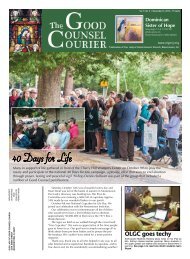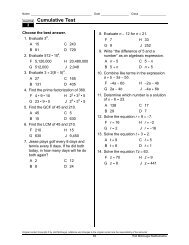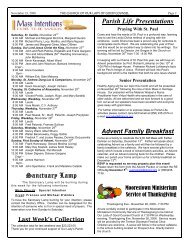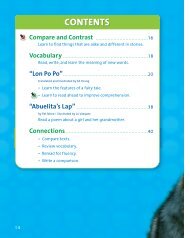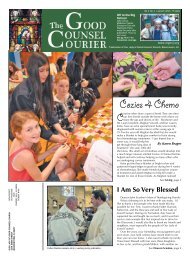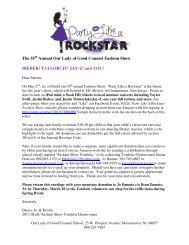Chapter 3 Resource: Interactions of Human Systems
Chapter 3 Resource: Interactions of Human Systems
Chapter 3 Resource: Interactions of Human Systems
You also want an ePaper? Increase the reach of your titles
YUMPU automatically turns print PDFs into web optimized ePapers that Google loves.
Glencoe Science<br />
<strong>Chapter</strong> <strong>Resource</strong>s<br />
Includes:<br />
<strong>Interactions</strong> <strong>of</strong> <strong>Human</strong> <strong>Systems</strong><br />
Reproducible Student Pages<br />
ASSESSMENT<br />
✔ <strong>Chapter</strong> Tests<br />
✔ <strong>Chapter</strong> Review<br />
HANDS-ON ACTIVITIES<br />
✔ Lab Worksheets for each Student Edition Activity<br />
✔ Laboratory Activities<br />
✔ Foldables–Reading and Study Skills activity sheet<br />
MEETING INDIVIDUAL NEEDS<br />
✔ Directed Reading for Content Mastery<br />
✔ Directed Reading for Content Mastery in Spanish<br />
✔ Reinforcement<br />
✔ Enrichment<br />
✔ Note-taking Worksheets<br />
TRANSPARENCY ACTIVITIES<br />
✔ Section Focus Transparency Activities<br />
✔ Teaching Transparency Activity<br />
✔ Assessment Transparency Activity<br />
Teacher Support and Planning<br />
✔ Content Outline for Teaching<br />
✔ Spanish <strong>Resource</strong>s<br />
✔ Teacher Guide and Answers
Glencoe Science<br />
Photo Credits<br />
Section Focus Transparency 1: SuperStock<br />
Section Focus Transparency 2: Dr. Arthur Tucker/Science Photo Library/Photo Researchers<br />
Teaching Transparency: Bob Daemmrich<br />
Copyright © by The McGraw-Hill Companies, Inc. All rights reserved.<br />
Permission is granted to reproduce the material contained herein on the condition<br />
that such material be reproduced only for classroom use; be provided to students,<br />
teachers, and families without charge; and be used solely in conjunction with the<br />
<strong>Interactions</strong> <strong>of</strong> <strong>Human</strong> <strong>Systems</strong> program. Any other reproduction, for use or sale,<br />
is prohibited without prior written permission <strong>of</strong> the publisher.<br />
Send all inquiries to:<br />
Glencoe/McGraw-Hill<br />
8787 Orion Place<br />
Columbus, OH 43240-4027<br />
ISBN 0-07-867147-7<br />
Printed in the United States <strong>of</strong> America.<br />
1 2 3 4 5 6 7 8 9 10 024 09 08 07 06 05 04
Reproducible<br />
Student Pages<br />
Reproducible Student Pages<br />
■ Hands-On Activities<br />
MiniLAB: Try at Home Observing the Gases That You Exhale. . . . . . . 3<br />
MiniLAB: Observing a Chemical Reaction . . . . . . . . . . . . . . . . . . . . . . 4<br />
Lab: Observing Cells . . . . . . . . . . . . . . . . . . . . . . . . . . . . . . . . . . . . . . . 5<br />
Lab: Design Your Own Does Exercise Affect Respiration. . . . . . . . . . . 7<br />
Laboratory Activity 1: Minerals and Good Health . . . . . . . . . . . . . . . . 9<br />
Laboratory Activity 2: Transporting Nutrients . . . . . . . . . . . . . . . . . . 15<br />
Foldables: Reading and Study Skills. . . . . . . . . . . . . . . . . . . . . . . . . . 19<br />
■ Meeting Individual Needs<br />
Extension and Intervention<br />
Directed Reading for Content Mastery . . . . . . . . . . . . . . . . . . . . . . . 21<br />
Directed Reading for Content Mastery in Spanish . . . . . . . . . . . . . . 25<br />
Reinforcement . . . . . . . . . . . . . . . . . . . . . . . . . . . . . . . . . . . . . . . . . . 29<br />
Enrichment. . . . . . . . . . . . . . . . . . . . . . . . . . . . . . . . . . . . . . . . . . . . . 31<br />
Note-taking Worksheet . . . . . . . . . . . . . . . . . . . . . . . . . . . . . . . . . . . 33<br />
■ Assessment<br />
<strong>Chapter</strong> Review . . . . . . . . . . . . . . . . . . . . . . . . . . . . . . . . . . . . . . . . . 37<br />
<strong>Chapter</strong> Test . . . . . . . . . . . . . . . . . . . . . . . . . . . . . . . . . . . . . . . . . . . . 39<br />
■ Transparency Activities<br />
Section Focus Transparency Activities . . . . . . . . . . . . . . . . . . . . . . . . 44<br />
Teaching Transparency Activity . . . . . . . . . . . . . . . . . . . . . . . . . . . . . 47<br />
Assessment Transparency Activity . . . . . . . . . . . . . . . . . . . . . . . . . . . 49<br />
<strong>Interactions</strong> <strong>of</strong> <strong>Human</strong> <strong>Systems</strong> 1
Hands-On Activities<br />
Hands-On<br />
Activities<br />
2 <strong>Interactions</strong> <strong>of</strong> <strong>Human</strong> <strong>Systems</strong>
Name Date Class<br />
Observing the Gases That You Exhale<br />
Procedure<br />
1. Dry your hands with a towel.<br />
2. Hold the palm <strong>of</strong> your hand up to your mouth, then exhale into it.<br />
3. Feel your palm with your other hand. Record your observations in the Data<br />
and Observations section.<br />
4. Hold a mirror up to your mouth and exhale again. Observe what happens to<br />
the mirror. Record your observations in the Data and Observations section.<br />
Hands-On Activities<br />
Data and Observations<br />
Copyright © Glencoe/McGraw-Hill, a division <strong>of</strong> the McGraw-Hill Companies, Inc.<br />
Analysis<br />
1. How did your hand feel after you breathed on it<br />
2. What happened to the mirror when you breathed on it<br />
3. Besides carbon dioxide, hypothesize what other things are exhaled.<br />
<strong>Interactions</strong> <strong>of</strong> <strong>Human</strong> <strong>Systems</strong> 3
Name Date Class<br />
Hands-On Activities<br />
Observing a Chemical Reaction<br />
Procedure<br />
1. Pour a small amount <strong>of</strong> 3% hydrogen peroxide solution into a petri dish.<br />
2. Use a thermometer probe to take the temperature <strong>of</strong> the peroxide solution.<br />
3. Place a small chunk <strong>of</strong> fresh liver in the petri dish. Observe what happens.<br />
Record your observations in the Data and Observations section.<br />
4. Wait 1 min, then take the temperature <strong>of</strong> the solution a second time.<br />
Data and Observations<br />
Temperature <strong>of</strong><br />
hydrogen peroxide<br />
solution<br />
Observations <strong>of</strong><br />
hydrogen peroxide<br />
solution and liver<br />
Temperature<br />
after 1 min<br />
Analysis<br />
1. Was energy released during this chemical reaction How do you know<br />
2. How is this chemical reaction similar to the process <strong>of</strong> respiration in cells<br />
Copyright © Glencoe/McGraw-Hill, a division <strong>of</strong> the McGraw-Hill Companies, Inc.<br />
4 <strong>Interactions</strong> <strong>of</strong> <strong>Human</strong> <strong>Systems</strong>
Name Date Class<br />
Observing Cells<br />
Lab Preview<br />
Directions: Answer these questions before you begin the Lab.<br />
1. What toxic substance does the skull and crossbones symbol warn against<br />
Hands-On Activities<br />
2. What two microscope settings will you use to examine the cheek cells and the onion cells<br />
Cells come in a variety <strong>of</strong> shapes and sizes. They might look different and<br />
perform different functions, but they have some common structures.<br />
Copyright © Glencoe/McGraw-Hill, a division <strong>of</strong> the McGraw-Hill Companies, Inc.<br />
Real-World Question<br />
How do prepared human cheek cells and living onion cells compare<br />
Materials<br />
compound light microscope<br />
microscope slide<br />
coverslip<br />
prepared human cheek cell slide<br />
small piece <strong>of</strong> onion<br />
Goals<br />
■ Observe the structure <strong>of</strong> human cheek cells.<br />
■ Observe the structure <strong>of</strong> onion cells.<br />
Safety Precautions<br />
forceps<br />
iodine solution<br />
water<br />
medicine dropper<br />
WARNING: These solutions can cause stains. Do not allow them to contact your skin or clothing.<br />
Procedure<br />
1. Obtain a prepared slide <strong>of</strong> human cheek<br />
cells from your teacher.<br />
2. Examine the cheek cells under low power<br />
<strong>of</strong> the microscope and then under high<br />
power. In the Data and Observations<br />
section, draw several cheek cells as they<br />
appear under high power.<br />
3. Using forceps, remove a small section <strong>of</strong><br />
paper-thin tissue from the onion. Prepare a<br />
wet-mount slide <strong>of</strong> the onion tissue. Before<br />
putting on the coverslip, place a drop <strong>of</strong><br />
iodine on the onion tissue.<br />
4. Examine the onion-tissue slide under low<br />
power, then under high power. In the Data<br />
and Observations section, draw several<br />
onion cells as they appear under high<br />
power.<br />
<strong>Interactions</strong> <strong>of</strong> <strong>Human</strong> <strong>Systems</strong> 5
Name Date Class<br />
(continued)<br />
Hands-On Activities<br />
Data and Observations<br />
<strong>Human</strong> Cheek Cell Drawings<br />
Onion Cell Drawings<br />
Conclude and Apply<br />
1. Describe the shape <strong>of</strong> human cheek cells.<br />
2. Describe the shape <strong>of</strong> the onion cells.<br />
3. Name the structure you saw in the onion cell but not in the human cheek cell.<br />
Communicating Your Data<br />
Copyright © Glencoe/McGraw-Hill, a division <strong>of</strong> the McGraw-Hill Companies, Inc.<br />
Make a colorful, poster-sized illustration <strong>of</strong> one <strong>of</strong> these cells. Label all visible parts <strong>of</strong> the<br />
cell. For more help, refer to the Science Skill Handbook.<br />
6 <strong>Interactions</strong> <strong>of</strong> <strong>Human</strong> <strong>Systems</strong>
Name Date Class<br />
Design Your Own<br />
Does Exercise Affect Respiration<br />
Lab Preview<br />
Directions: Answer these questions before you begin the Lab.<br />
1. Why are balloons listed as a possible material<br />
Hands-On Activities<br />
2. What purpose does an indicator solution like bromthymol blue serve<br />
When you exercise, muscle cells in your body use up a lot <strong>of</strong> energy. Carbon<br />
dioxide is a waste product <strong>of</strong> respiration, the energy-releasing process in your<br />
cells.<br />
Copyright © Glencoe/McGraw-Hill, a division <strong>of</strong> the McGraw-Hill Companies, Inc.<br />
Real-World Question<br />
Does exercise affect the amount <strong>of</strong> carbon<br />
dioxide exhaled by the lungs<br />
Form a Hypothesis<br />
Make a hypothesis about how exercise affects<br />
respiration. Will exercise increase or decrease<br />
the amount <strong>of</strong> carbon dioxide you exhale<br />
Possible Materials<br />
graduated cylinder<br />
large beakers (2)<br />
straws (2)<br />
balloons (2)<br />
bromthymol blue indicator solution (200 mL)<br />
stopwatch<br />
*clock with a second hand<br />
glass-marking pencil<br />
*Alternate materials<br />
Goals<br />
■ Observe the effect <strong>of</strong> carbon dioxide on the<br />
bromthymol blue indicator solution.<br />
■ Predict how exercise will affect the amount <strong>of</strong><br />
carbon dioxide that is exhaled by the body.<br />
Safety Precautions<br />
Test Your Hypothesis<br />
Make a Plan<br />
1. As a group, predict how exercise will affect<br />
the amount <strong>of</strong> carbon dioxide exhaled by<br />
the lungs. Identify a way that you can test<br />
your hypothesis.<br />
2. List the steps you will follow to test your<br />
hypothesis. Be sure to describe exactly what<br />
you will do in each step.<br />
3. Make a data table in your Science Journal<br />
to record your observations.<br />
4. Read over your entire experimental<br />
procedure. Do the steps make sense Are<br />
they arranged in the correct order<br />
Follow Your Plan<br />
1. Make sure your teacher approves your plan<br />
and your data table before you start.<br />
2. Carry out the experiment according to the<br />
approved plan.<br />
3. Record all <strong>of</strong> your observations in your<br />
data table.<br />
<strong>Interactions</strong> <strong>of</strong> <strong>Human</strong> <strong>Systems</strong> 7
Name Date Class<br />
(continued)<br />
Hands-On Activities<br />
Analyze Your Data<br />
1. What caused the indicator solution to change color Describe the color change.<br />
2. Compare the time it took the bromthymol blue indicator solution to change color before exercising<br />
and after exercising.<br />
3. Compare your results with the results <strong>of</strong> other groups in your class.<br />
Conclude and Apply<br />
1. Explain whether the results supported your hypothesis.<br />
2. Describe how exercise affects the amount <strong>of</strong> carbon dioxide you exhale.<br />
Communicating Your Data<br />
Prepare a poster project showing how increasing levels <strong>of</strong> activity affect the production <strong>of</strong><br />
carbon dioxide. Include photos, a data table, and a step-by-step procedure.<br />
Copyright © Glencoe/McGraw-Hill, a division <strong>of</strong> the McGraw-Hill Companies, Inc.<br />
8 <strong>Interactions</strong> <strong>of</strong> <strong>Human</strong> <strong>Systems</strong>
Name Date Class<br />
Copyright © Glencoe/McGraw-Hill, a division <strong>of</strong> the McGraw-Hill Companies, Inc.<br />
1<br />
Laboratory<br />
Activity<br />
Minerals and Good Health<br />
Minerals and other inorganic substances are essential for a healthy growing body. Calcium,<br />
phosphorus, and magnesium all contribute to bone growth. Iron helps your blood carry oxygen<br />
from your lungs and bring back carbon dioxide. Minerals bond with organic molecules to help your<br />
cells function properly. Minerals are especially important for young people. Children who grow up<br />
in some <strong>of</strong> the poorer regions <strong>of</strong> the world are at highest risk for mineral deficiencies. Most <strong>of</strong> the<br />
minerals people need come from various foods and from water. What you eat has a huge impact on<br />
what minerals you get. Scientists have come up with a standard recommendation for quantities <strong>of</strong><br />
each mineral required to maintain a healthy body. The standard, called Recommended Daily<br />
Allowance (RDA), provides guidelines as to how much <strong>of</strong> each mineral the human body can use<br />
each day. The Reference Daily Intake, based on the RDA, provides a guideline as to how much <strong>of</strong><br />
each mineral a person should consume each day in order to maintain healthy mineral levels. Labels<br />
on foods are required to include information about how much <strong>of</strong> the RDA for various vitamins and<br />
minerals that product provides per serving. In this laboratory activity, you will be looking at RDAs,<br />
RDIs, and labels for various foods and collecting data on how you can meet your mineral needs.<br />
Strategy<br />
You will research and record the quantities <strong>of</strong> certain nutritional minerals in typical servings <strong>of</strong><br />
various foods.<br />
You will determine if these foods satisfy established daily requirements for those minerals.<br />
You will identify which body parts or functions use certain minerals.<br />
Materials<br />
Nutrition Facts labels from various packaged<br />
foods<br />
potato chips<br />
frozen dinner<br />
corn flakes<br />
2% milk<br />
whole wheat bread<br />
hamburger buns<br />
margarine<br />
orange juice<br />
tuna fish<br />
mayonnaise<br />
vegetable or tomato juice<br />
canned peaches<br />
vanilla wafers or other cookies<br />
apple sauce<br />
canned green beans<br />
Italian or other salad dressing<br />
chocolate pudding<br />
soda pop<br />
maple syrup<br />
Procedure<br />
1. Choosing from the items for which you<br />
have labels in your classroom and the<br />
additional items in Table 2, assemble a one<br />
day menu for yourself. Enter your selection<br />
in Table 1.<br />
2. For each menu item, record the mineral<br />
content information in Table 1. You will find<br />
this information in the Nutrition Facts<br />
panel from the food packaging or in Table 2.<br />
3. Calculate the total mineral intake for each<br />
mineral for the day’s menu and record<br />
your findings in Table 1.<br />
4. Compare your results with the RDIs listed<br />
for each mineral in Table 3.<br />
5. Examine Table 1 in your textbook to find<br />
other types <strong>of</strong> foods that might be used to<br />
make up any shortcomings in your menu’s<br />
mineral content. Remember, though, that<br />
replacing one food with another to increase<br />
a particular mineral might cause a reduction<br />
in a different mineral. Record your ideas in<br />
the Data and Observations section.<br />
Hands-On Activities<br />
<strong>Interactions</strong> <strong>of</strong> <strong>Human</strong> <strong>Systems</strong> 9
Name Date Class<br />
Laboratory Activity 1 (continued)<br />
Hands-On Activities<br />
Data and Observations<br />
Table 1<br />
Menu<br />
Sodium (mg) Calcium (mg) Potassium (mg) Iron (mg)<br />
Breakfast<br />
Lunch<br />
Dinner<br />
Total mineral<br />
intake<br />
Copyright © Glencoe/McGraw-Hill, a division <strong>of</strong> the McGraw-Hill Companies, Inc.<br />
10 <strong>Interactions</strong> <strong>of</strong> <strong>Human</strong> <strong>Systems</strong>
Name Date Class<br />
Laboratory Activity 1 (continued)<br />
Copyright © Glencoe/McGraw-Hill, a division <strong>of</strong> the McGraw-Hill Companies, Inc.<br />
Table 2<br />
Mineral–Amount per Serving<br />
Type <strong>of</strong> Food Sodium (mg) Calcium (mg) Potassium (mg) Iron (mg)<br />
Hamburger 660 20 190 2<br />
Chicken (roast) 70 9 270 8<br />
Beef (roast) 55 10 300 2<br />
Pork chop 70 9 300 9<br />
Pizza (cheese/tomato) 340 240 180 1<br />
Cheddar cheese 610 800 120 4<br />
Cheese (processed) 1360 700 80 5<br />
Egg (scrambled) 1050 60 130 2<br />
Pancake 50 120 140 9<br />
Strawberries (4) 0.5 7 80 0.2<br />
Apple 2 3 90 2<br />
Banana 1 7 350 4<br />
Orange 2 30 150 3<br />
Carrot (raw) 100 50 220 0.6<br />
Broccoli (boiled) 6 80 220 1<br />
Potato (baked) 6 8 550 0.6<br />
Tomato (raw) 3 10 290 0.4<br />
Doughnut 60 70 110 2<br />
Cheesecake 260 70 120 7<br />
Table 3<br />
Mineral<br />
US-RDI<br />
Calcium<br />
1,000 mg<br />
Iron 10 mg, males; 18 mg, females<br />
Potassium<br />
99 mg<br />
Sodium<br />
30–2,300 mg<br />
*Note: RDA for potassium can safely go as high as 2,000 mg<br />
Hands-On Activities<br />
<strong>Interactions</strong> <strong>of</strong> <strong>Human</strong> <strong>Systems</strong> 11
Name Date Class<br />
Laboratory Activity 1 (continued)<br />
Hands-On Activities<br />
1. Is there too much or too little <strong>of</strong> any mineral in your menu, as compared with the RDIs If so,<br />
what do you think is the reason<br />
2. What foods could you change or add to your menu to increase the minerals your menu is lacking<br />
3. Study the Tables on page 11.<br />
a. Which type <strong>of</strong> food in Table 2 is the highest in calcium<br />
b. Does one serving <strong>of</strong> this food meet the daily requirement for calcium Explain.<br />
Questions and Conclusions<br />
1. Did your menu meet all the RDIs for the four minerals you examined If not, which minerals<br />
fell short<br />
2. Suggest any possible shortcomings you see for the possible replacement foods you listed<br />
increase certain minerals in your menu.<br />
3. Did any <strong>of</strong> the foods you selected provide the entire day’s RDI Which<br />
4. According to Table 1 from your text, what body parts or functions benefit from the minerals<br />
you examined<br />
Copyright © Glencoe/McGraw-Hill, a division <strong>of</strong> the McGraw-Hill Companies, Inc.<br />
12 <strong>Interactions</strong> <strong>of</strong> <strong>Human</strong> <strong>Systems</strong>
Name Date Class<br />
Laboratory Activity 1 (continued)<br />
5. Do you think it’s important for young people to eat a wide variety <strong>of</strong> foods to get the minerals<br />
they need Why<br />
Strategy Check<br />
Can you research and record quantities <strong>of</strong> certain nutritional minerals in typical servings<br />
<strong>of</strong> various foods<br />
Can you determine if those foods satisfy established daily requirements for those minerals<br />
Can you identify which body parts or functions use certain minerals<br />
Hands-On Activities<br />
Copyright © Glencoe/McGraw-Hill, a division <strong>of</strong> the McGraw-Hill Companies, Inc.<br />
<strong>Interactions</strong> <strong>of</strong> <strong>Human</strong> <strong>Systems</strong> 13
Name Date Class<br />
Copyright © Glencoe/McGraw-Hill, a division <strong>of</strong> the McGraw-Hill Companies, Inc.<br />
2<br />
Laboratory<br />
Activity<br />
Transporting Nutrients<br />
The cells in your body get the nutrition they need by passing substances across their membranes.<br />
Some substances pass easily across the membranes. Others need some help in the form <strong>of</strong> energy or<br />
membrane proteins. Membranes that allow some substances to pass through easily, but not others,<br />
are called semipermeable membranes. In this laboratory, you will examine some <strong>of</strong> the processes by<br />
which nutrients and wastes enter and leave a cell. Diffusion and osmosis are the most common<br />
ways substances pass through a membrane. You will simulate these processes and be able to observe<br />
a semipermeable membrane.<br />
Strategy<br />
You will observe diffusion.<br />
You will observe and describe how a<br />
semipermeable membrane works.<br />
Materials<br />
water<br />
test tube<br />
potassium permanganate<br />
(two or three large crystals)<br />
test-tube rack<br />
metric ruler<br />
500-mL beaker<br />
dialysis bagging cut into 2 6–8-cm strips<br />
rubber bands or string (2 pieces, 8 cm)<br />
masking tape (2 pieces, 4 cm)<br />
measuring spoons<br />
dark corn syrup<br />
Procedure<br />
Part A—Observing Diffusion<br />
1. Pour water into a test tube until it is about<br />
three-fourths full.<br />
2. Your teacher will put two to three large<br />
crystals <strong>of</strong> potassium permanganate into<br />
your test tube. As the potassium permanganate<br />
becomes diluted, it will turn a deep<br />
purple. WARNING: Potassium permanganate<br />
is an irritant, and it will also stain<br />
your clothing. Be careful when handling it.<br />
3. Put the test tube in the test-tube rack. Do<br />
not touch or shake the test tube in any way.<br />
Note the time in Table 1 in the Data and<br />
Observations section.<br />
4. After 10 minutes, observe the color change<br />
in the water. Measure the highest point the<br />
deep purple color has reached. Record your<br />
measurement in Table 1 in the Data and<br />
Observations section.<br />
5. Repeat step 4 two more times.<br />
Part B—Observing a Semipermeable<br />
Membrane<br />
1. Pour water into a 500-mL beaker until it is<br />
about half-full <strong>of</strong> water. Be sure there is<br />
plenty <strong>of</strong> room to put your bagging in it<br />
without spilling the water.<br />
2. Take one end <strong>of</strong> the dialysis bagging and tie<br />
it <strong>of</strong>f securely with a rubber band or string.<br />
3. Open the other end <strong>of</strong> the bagging. The<br />
bagging will probably be very difficult to<br />
pry open, just like some supermarket plastic<br />
bags. If the tubing is dry, place masking<br />
tape on your thumb and forefinger and pull<br />
aside the edges <strong>of</strong> the open end. If it is wet,<br />
rub the edges <strong>of</strong> the open end until they<br />
come apart.<br />
4. Place about 1 teaspoon <strong>of</strong> the dark corn<br />
syrup in the bag and tie <strong>of</strong>f that end as you<br />
did the other.<br />
5. Place the entire bag, with corn syrup in<br />
it, into the water beaker. Record your<br />
observations <strong>of</strong> the bag in Table 2 in the<br />
Data and Observations section.<br />
6. Wait for 20 minutes and observe the bag<br />
<strong>of</strong> corn syrup. Record your observations<br />
in Table 2 in the Data and Observations<br />
section.<br />
Hands-On Activities<br />
<strong>Interactions</strong> <strong>of</strong> <strong>Human</strong> <strong>Systems</strong> 15
Name Date Class<br />
Laboratory Activity 2 (continued)<br />
Hands-On Activities<br />
Data and Observations<br />
Table 1<br />
Beginning Time<br />
Height (cm) Height (cm) Height (cm)<br />
after 10 Minutes after 20 Minutes after 30 Minutes<br />
Table 2<br />
Beginning Observations:<br />
After 20 Minutes:<br />
Questions and Conclusions<br />
1. What happened to the color <strong>of</strong> the water in the test tube with the potassium permanganate<br />
Copyright © Glencoe/McGraw-Hill, a division <strong>of</strong> the McGraw-Hill Companies, Inc.<br />
16 <strong>Interactions</strong> <strong>of</strong> <strong>Human</strong> <strong>Systems</strong>
Name Date Class<br />
Laboratory Activity 2 (continued)<br />
2. What can you conclude about how some cells in your body get some <strong>of</strong> their nutrition<br />
3. In the experiment with the corn syrup, did the water enter the bag<br />
Hands-On Activities<br />
4. Did the corn syrup appear to leave the bag<br />
5. Which substance do you think has larger molecules—water or corn syrup Why<br />
Copyright © Glencoe/McGraw-Hill, a division <strong>of</strong> the McGraw-Hill Companies, Inc.<br />
6. This type <strong>of</strong> barrier is called a semipermeable membrane. What does it mean when the<br />
membrane <strong>of</strong> a human cell is called semipermeable<br />
Strategy Check<br />
Can you observe diffusion<br />
Can you observe and describe how a semipermeable membrane works<br />
<strong>Interactions</strong> <strong>of</strong> <strong>Human</strong> <strong>Systems</strong> 17
Name Date Class<br />
<strong>Interactions</strong> <strong>of</strong> <strong>Human</strong> <strong>Systems</strong><br />
Copyright © Glencoe/McGraw-Hill, a division <strong>of</strong> the McGraw-Hill Companies, Inc.<br />
Directions: Use this page to label your Foldable at the beginning <strong>of</strong> the chapter.<br />
mineral<br />
organic compound<br />
cell<br />
tissue<br />
organ<br />
organ system<br />
digestion<br />
enzyme<br />
villi<br />
absorption<br />
cellular respiration<br />
alveoli<br />
excretion<br />
homeostasis<br />
negative feedback<br />
Hands-On Activities<br />
<strong>Interactions</strong> <strong>of</strong> <strong>Human</strong> <strong>Systems</strong> 19
Meeting Individual Needs<br />
Meeting Individual<br />
Needs<br />
20 <strong>Interactions</strong> <strong>of</strong> <strong>Human</strong> <strong>Systems</strong>
Name Date Class<br />
Directed Reading for<br />
Content Mastery<br />
Overview<br />
<strong>Interactions</strong> <strong>of</strong> <strong>Human</strong> <strong>Systems</strong><br />
Directions: The flow chart below shows levels <strong>of</strong> organization in the human body. In the spaces provided, write<br />
these levels in order from simplest to most complex.<br />
organ tissue organism cell organ system<br />
Simplest<br />
1.<br />
2.<br />
3.<br />
4.<br />
5.<br />
Meeting Individual Needs<br />
Copyright © Glencoe/McGraw-Hill, a division <strong>of</strong> the McGraw-Hill Companies, Inc.<br />
Directions: Complete the following sentences using the terms listed below.<br />
urinary homeostasis digestive negative respiratory<br />
6. The circulatory and ____________________ systems work together to break<br />
down food and transport it to the cells.<br />
7. The circulatory and ____________________ systems work together to release<br />
carbon dioxide and take in oxygen.<br />
8. The circulatory and ____________________ systems work together to remove<br />
wastes and return water, sugar, and salt to the blood.<br />
9. Your body has the ability to respond to changes and keep its internal environment<br />
stable. The process by which it does this is called ____________________.<br />
10. Bodily responses that occur when you exercise or become overheated are called<br />
____________________ feedback.<br />
Most complex<br />
<strong>Interactions</strong> <strong>of</strong> <strong>Human</strong> <strong>Systems</strong> 21
Name Date Class<br />
Directed Reading for<br />
Content Mastery<br />
Section 1 ■<br />
The <strong>Human</strong><br />
Organism<br />
Directions: Use the clues below to complete the crossword puzzle.<br />
4<br />
1 2<br />
3<br />
L<br />
Meeting Individual Needs<br />
7<br />
5<br />
I<br />
L<br />
8<br />
P<br />
C<br />
B<br />
R<br />
Y<br />
6<br />
G<br />
P<br />
D<br />
Across<br />
2. The smaller units that make up tissues<br />
5. Organic compounds that store information needed for making proteins<br />
7. Organic compounds that are the main energy source <strong>of</strong> all living things<br />
8. Organic compounds that make up many <strong>of</strong> the body’s structures (such as skin<br />
and muscles) and that help carry out body processes (such as digestion)<br />
Down<br />
1. An inorganic substance that plays an important part <strong>of</strong> nearly every body process<br />
3. Another name for a fat or an oil; an organic compound that is stored in the body<br />
as an energy reserve<br />
4. Inorganic substances, such as calcium and iron, that are needed by the body in<br />
small amounts<br />
6. Examples include the stomach, brain, and heart<br />
Copyright © Glencoe/McGraw-Hill, a division <strong>of</strong> the McGraw-Hill Companies, Inc.<br />
22 <strong>Interactions</strong> <strong>of</strong> <strong>Human</strong> <strong>Systems</strong>
Name Date Class<br />
Directed Reading for<br />
Content Mastery<br />
Section 2 ■<br />
How Your Body<br />
Works<br />
Directions: For each <strong>of</strong> the following, write the letter <strong>of</strong> the term or phrase that best completes the sentence.<br />
Copyright © Glencoe/McGraw-Hill, a division <strong>of</strong> the McGraw-Hill Companies, Inc.<br />
1. The main organs <strong>of</strong> the respiratory system are the ______.<br />
a. kidneys b. lungs<br />
2. ______ is the process by which the body maintains a stable internal<br />
environment.<br />
a. Homeostasis b. Absorption<br />
3. Positive feedback mechanisms are ______ common in the body than<br />
negative feedback mechanisms are.<br />
a. more b. less<br />
4. The digestive system and the ______ system work together to break<br />
down food and transport it to cells.<br />
a. excretory b. circulatory<br />
5. Food molecules pass from the small intestine into the bloodstream<br />
through tiny fingerlike projections called ______.<br />
a. villi b. nephrons<br />
6. ______ is a process in which food molecules and oxygen are combined<br />
to release energy. This process produces carbon dioxide and water as<br />
wastes.<br />
a. Cellular respiration b. Digestion<br />
7. The waste liquid produced by the kidneys is called ______.<br />
a. sweat b. urine<br />
8. Shivering helps to increase the body’s temperature. Shivering when you<br />
are cold is an example <strong>of</strong> a ______ feedback mechanism.<br />
a. negative b. positive<br />
9. The clotting <strong>of</strong> blood is an example <strong>of</strong> ______ feedback.<br />
a. negative b. positive<br />
10. The circulatory system and the ______ system work together to remove<br />
carbon dioxide from the body.<br />
a. respiratory b. urinary<br />
Meeting Individual Needs<br />
<strong>Interactions</strong> <strong>of</strong> <strong>Human</strong> <strong>Systems</strong> 23
Name Date Class<br />
Directed Reading for<br />
Content Mastery<br />
Key Terms<br />
<strong>Interactions</strong> <strong>of</strong> <strong>Human</strong> <strong>Systems</strong><br />
Directions: Write the term that matches each description below on the spaces provided. Some letters have been<br />
provided. The letters in the dark, vertical box will spell the answer to question 10.<br />
H<br />
1<br />
G<br />
Meeting Individual Needs<br />
6<br />
2<br />
C<br />
5<br />
Z<br />
3<br />
B<br />
4<br />
R<br />
7<br />
V<br />
8<br />
9<br />
D<br />
S<br />
1. type <strong>of</strong> carbon-containing compounds that include proteins and lipids<br />
2. type <strong>of</strong> protein that helps carry out chemical reactions<br />
3. smallest functional unit <strong>of</strong> any living thing<br />
4. group <strong>of</strong> different tissues that perform a particular function<br />
5. process in which food molecules pass from the small intestine to the blood<br />
6. process in which wastes are removed from the body<br />
7. tiny sacs in the lungs through which oxygen and carbon dioxide are exchanged<br />
8. group <strong>of</strong> similar cells that perform a function<br />
9. process in which the body breaks down food into molecules that can be used by cells<br />
10. find the hidden word that answers this question: What body process is most<br />
like Goldilocks (Hint: It keeps your body “just right.”)<br />
Copyright © Glencoe/McGraw-Hill, a division <strong>of</strong> the McGraw-Hill Companies, Inc.<br />
24 <strong>Interactions</strong> <strong>of</strong> <strong>Human</strong> <strong>Systems</strong>
Nombre Fecha Clase<br />
Lectura dirigida para<br />
Dominio del contenido<br />
Sinopsis<br />
Interacciones entre los<br />
sistemas humanos<br />
Instrucciones: El siguiente diagrama de flujo muestra los niveles de organización del cuerpo humano. En los<br />
espacios dados, escribe estos niveles en orden, desde el más simple al más complejo.<br />
órgano tejido organismo célula sistema de órganos<br />
Más simple<br />
Copyright © Glencoe/McGraw-Hill, a division <strong>of</strong> the McGraw-Hill Companies, Inc.<br />
Instrucciones: Completa las siguientes oraciones usando los términos de la lista.<br />
urinario homeostasis digestivo negativa respiratorio<br />
6. Los sistemas circulatorio y ____________________ funcionan juntos para<br />
desintegrar los alimentos y transportarlos a las células.<br />
7. Los sistemas circulatorio y ____________________ funcionan juntos para<br />
liberar dióxido de carbono y tomar oxígeno.<br />
8. Los sistemas circulatorio y ____________________ funcionan juntos para<br />
eliminar desechos y devolver agua, azúcar y sales a la sangre.<br />
1.<br />
2.<br />
3.<br />
4.<br />
5.<br />
Más complejo<br />
9. Tu cuerpo tiene la capacidad de responder a los cambios y mantener su ambiente<br />
interno estable. El proceso que usa para esto se llama ____________________.<br />
Satisface las necesidades individuales<br />
10. Las respuestas corporales que ocurren cuando haces ejercicios o te sobrecalientas<br />
se llaman retroalimentación ____________________.<br />
Interacciones entre los sistemas humanos 25
Nombre Fecha Clase<br />
Lectura dirigida para<br />
Dominio del contenido<br />
Sección 1 ■<br />
El organismo<br />
humano<br />
Instrucciones: Usa las pistas para hacer el crucigrama.<br />
1 2 3<br />
D<br />
E<br />
Satisface las necesidades individuales<br />
7<br />
Horizontales<br />
U<br />
R<br />
4<br />
N<br />
1. Compuestos orgánicos que almacenan la información necesaria para elaborar<br />
proteínas<br />
4. Sustancia inorgánica que juega un papel importante en casi todos los procesos<br />
celulares<br />
7. Compuestos orgánicos que son la fuente más importante de energía para los seres<br />
vivos<br />
8. Sustancias inorgánicas, como el calcio y el hierro, que el cuerpo necesita en<br />
pequeñas cantidades<br />
Verticales<br />
2. Las unidades más pequeñas que forman los tejidos<br />
3. Ejemplos son el estómago, el encéfalo y el corazón<br />
6<br />
A<br />
I<br />
8<br />
5. Compuestos orgánicos que forman muchas de las estructuras del cuerpo (como<br />
la piel y los músculos) y que ayudan a llevar a cabo los procesos corporales<br />
(como la digestión)<br />
6. Otro nombre que se da a las grasas y aceites; compuesto orgánico que el cuerpo<br />
acumula como reserva de energía<br />
T<br />
5<br />
S<br />
L<br />
Copyright © Glencoe/McGraw-Hill, a division <strong>of</strong> the McGraw-Hill Companies, Inc.<br />
26 Interacciones entre los sistemas humanos
Nombre Fecha Clase<br />
Lectura dirigida para<br />
Dominio del contenido<br />
Sección 2 ■<br />
Funcionamiento<br />
del cuerpo<br />
Instrucciones: En cada una de las siguientes, escribe la letra del término que complete mejor cada oración.<br />
Copyright © Glencoe/McGraw-Hill, a division <strong>of</strong> the McGraw-Hill Companies, Inc.<br />
1. Los principales órganos del sistema respiratorio son los ______.<br />
a. riñones b. pulmones<br />
2. La ______ es el proceso por medio del cual el cuerpo mantiene un<br />
ambiente interno estable.<br />
a. homeostasis b. absorción<br />
3. Los mecanismos de retroalimentación positiva son ______ comunes en<br />
el cuerpo que los mecanismos de retroalimentación negativa.<br />
a. más b. menos<br />
4. El sistema digestivo y el sistema ______ trabajan juntos para desintegrar<br />
los alimentos y transportarlos a las células.<br />
a. excretorio b. circulatorio<br />
5. Las moléculas de alimento pasan del intestino delgado al flujo sanguíneo<br />
a través de pequeñas proyecciones tipo dedos llamadas ______.<br />
a. microvellosidades b. nefrones<br />
6. La ______ es el proceso en que se combinan las moléculas alimenticias<br />
y el oxígeno para liberar energía. Este proceso produce dióxido de carbono<br />
y agua como desechos.<br />
a. respiración celular b. digestión<br />
7. El desecho líquido que producen los riñones se llama ______.<br />
a. sudor b. orina<br />
8. El tiritar ayuda a elevar la temperatura corporal. El tiritar cuando tienes<br />
frío es ejemplo de un mecanismo de retroalimentación ______ .<br />
a. negativa b. positiva<br />
9. La coagulación de la sangre es ejemplo de retroalimentación ______ .<br />
a. negativa b. positiva<br />
10. El sistema circulatorio y el sistema ______ trabajan juntos para eliminar<br />
el dióxido de carbono del cuerpo.<br />
a. respiratorio b. urinario<br />
Satisface las necesidades individuales<br />
Interacciones entre los sistemas humanos 27
Nombre Fecha Clase<br />
Lectura dirigida para<br />
Dominio del contenido<br />
Términos claves<br />
Interacciones entre los<br />
sistemas humanos<br />
Instrucciones: Escribe el término que corresponde a cada descripción en los espacios dados. Se dan algunas<br />
letras. Las letras que aparecerán en la caja vertical oscura responden la pregunta 10.<br />
H<br />
1<br />
Satisface las necesidades individuales<br />
4<br />
6<br />
8<br />
2<br />
5<br />
3<br />
7<br />
9<br />
S<br />
1. tipo de compuestos del carbono que incluye proteínas y lípidos<br />
2. tipo de proteína que ayuda a que ocurran las reacciones químicas<br />
3. unidad funcional básica más pequeña de todos los seres vivos<br />
4. proceso mediante el cual se eliminan los desechos del cuerpo<br />
5. proceso mediante el cual las moléculas alimenticias pasan del intestino delgado<br />
a la sangre<br />
6. diferentes grupos de tejidos que llevan a cabo una función particular<br />
7. sacos diminutos en los pulmones a través de los cuales se intercambian el<br />
oxígeno y el dióxido de carbono<br />
8. grupo de tejidos que llevan a cabo una función específica<br />
9. grupo de células similares que trabajan juntas<br />
10. encuentra la palabra escondida que responde esta pregunta: ¿Cuál proceso corporal<br />
se parece más a Ricitos de Oro (Pista: Mantiene tu cuerpo "afinado".)<br />
Copyright © Glencoe/McGraw-Hill, a division <strong>of</strong> the McGraw-Hill Companies, Inc.<br />
28 Interacciones entre los sistemas humanos
Name Date Class<br />
1<br />
Reinforcement<br />
The <strong>Human</strong> Organism<br />
Directions: Write the term from the following list that matches each description on the line provided.<br />
carbohydrates lipids nucleic acids organic compounds proteins<br />
1. main source <strong>of</strong> energy<br />
2. most <strong>of</strong> the compounds containing carbon<br />
6. Explain how the above terms are related.<br />
3. large, complex compounds that store information in the form<br />
<strong>of</strong> code<br />
4. substances that are part <strong>of</strong> a person’s hair, nails, skin, muscles,<br />
and blood vessels<br />
5. stored in the body as energy reserves<br />
Meeting Individual Needs<br />
Copyright © Glencoe/McGraw-Hill, a division <strong>of</strong> the McGraw-Hill Companies, Inc.<br />
Directions: Select the term from the following list that matches each description.<br />
cell organ organ system tissues<br />
7. groups <strong>of</strong> similar cells that do the same kind <strong>of</strong> work<br />
8. structure made up <strong>of</strong> different types <strong>of</strong> tissues<br />
9. smallest functional unit in an organism<br />
10. groups <strong>of</strong> organs that work together to do a specific job<br />
11. Explain how the above terms are related.<br />
<strong>Interactions</strong> <strong>of</strong> <strong>Human</strong> <strong>Systems</strong> 29
Name Date Class<br />
2<br />
Reinforcement<br />
How Your Body Works<br />
Directions: Use the words in the list to fill in the blanks.<br />
alveoli enzymes villi absorbed<br />
cellular respiration carbon dioxide negative feedback<br />
Meeting Individual Needs<br />
1. In the process <strong>of</strong> ____________________________, oxygen combines with food molecules<br />
and energy is released.<br />
2. ____________________________ are proteins that help break down the chemicals in food.<br />
3. Nutrients are carried through the bloodstream after they are<br />
____________________________ in the small intestine.<br />
4. In the small intestine, nutrients pass through small, fingerlike projections,<br />
called ____________________________.<br />
5. Thin-walled sacs in the lungs are called ____________________________.<br />
6. Oxygen and ____________________________ are exchanged in the lungs.<br />
7. The mechanism <strong>of</strong> ____________________________ helps the body maintain homeostasis.<br />
Directions: Answer the following questions on the lines provided.<br />
8. Why is excretion an important life process<br />
9. What are nephrons What job do kidneys perform<br />
10. How do rapid breathing, flushing, and sweating help maintain homeostasis<br />
Copyright © Glencoe/McGraw-Hill, a division <strong>of</strong> the McGraw-Hill Companies, Inc.<br />
30 <strong>Interactions</strong> <strong>of</strong> <strong>Human</strong> <strong>Systems</strong>
Name Date Class<br />
1<br />
Enrichment<br />
Tissue Preservation<br />
Copyright © Glencoe/McGraw-Hill, a division <strong>of</strong> the McGraw-Hill Companies, Inc.<br />
At any given time, thousands <strong>of</strong> people experience<br />
failure <strong>of</strong> a body organ and require a<br />
replacement in order to survive. These people<br />
are on waiting lists for an organ or tissue transplant,<br />
a process in which the tissue or organ is<br />
removed from a donor and placed in a recipient.<br />
A major problem with the donation process<br />
is that a removed organ will survive outside the<br />
body for only a short period <strong>of</strong> time. Often<br />
organs must be transported long distances<br />
between the donor and recipient.<br />
Chilling Out<br />
To solve this problem, scientists have been<br />
working on methods <strong>of</strong> tissue preservation.<br />
One way <strong>of</strong> preserving tissue, although not<br />
viable for organ transplants, is to freeze it.<br />
Unfortunately, since cells contain significant<br />
amounts <strong>of</strong> water, just placing the tissue in a<br />
freezer would create ice crystals that would<br />
puncture the cell membranes. To prevent ice<br />
crystal formation, scientists use cryoprotectants,<br />
such as glycerol, which act as antifreeze<br />
agents. In addition, the cooling rate is carefully<br />
controlled. Once the samples are completely<br />
cooled, they are stored in liquid nitrogen. This<br />
method has been fairly successful. Even though<br />
scientists are not able to preserve all frozen<br />
cells, they can preserve enough cells that will<br />
divide and multiply once they are thawed.<br />
1. How can a cell become damaged when it is frozen<br />
Recently a new cryoprotectant has been discovered<br />
that has greatly increased the number<br />
<strong>of</strong> cells successfully preserved—a sugar called<br />
trehalose. Trehalose takes the place <strong>of</strong> water<br />
inside a cell and helps to protect the cell’s<br />
membranes, DNA, and enzymes from damage.<br />
More than 70 percent <strong>of</strong> cells treated with trehalose<br />
can survive. Another benefit <strong>of</strong> this<br />
sugar is that it can preserve cells that have<br />
been dried. Normally, dried human cells die<br />
after only one day. However, with trehalose,<br />
the cells can survive up to five days.<br />
Fresh Possibilities<br />
Scientists are exploring many new possibilities<br />
for freezing cells preserved with trehalose. For<br />
instance, some researchers are experimenting<br />
with using trehalose to preserve a woman’s<br />
ovaries while she undergoes cancer treatment.<br />
This would prevent a woman’s eggs from being<br />
exposed to the dangers <strong>of</strong> chemotherapy drugs.<br />
Other scientists are using trehalose to preserve<br />
dried vaccines. This eliminates the need to<br />
refrigerate the vaccines and could prolong their<br />
shelf life. With all the new research being done<br />
in the area <strong>of</strong> tissue preservation, scientists may<br />
one day be able to preserve organs indefinitely,<br />
so that anyone needing an organ or tissue transplant<br />
can receive one.<br />
2. List several methods scientists use to prevent cell damage when freezing cells.<br />
3. Currently most vaccines require almost constant refrigeration. How will the use <strong>of</strong> dried<br />
vaccines help health pr<strong>of</strong>essionals<br />
Meeting Individual Needs<br />
<strong>Interactions</strong> <strong>of</strong> <strong>Human</strong> <strong>Systems</strong> 31
Name Date Class<br />
2<br />
Enrichment<br />
Enzymes and Coenzymes<br />
Meeting Individual Needs<br />
Our bodies require energy to live. To get that<br />
energy from the food we eat, the food must first<br />
be processed by our digestive system, then<br />
absorbed by all <strong>of</strong> our cells. Our bodies perform<br />
two types <strong>of</strong> digestion simultaneously: physical<br />
breakdown and chemical breakdown. Physical<br />
breakdown is smashing food into smaller pieces.<br />
Chemical breakdown involves separating the<br />
molecules in the food and then digesting, or<br />
breaking apart, the bonds the molecules contain.<br />
Essential to chemical digestion are many<br />
enzymes that help perform molecular digestion<br />
at various stages <strong>of</strong> the digestive process.<br />
Shaping Up<br />
Each enzyme has a unique number <strong>of</strong> atoms<br />
and a unique shape. The shape <strong>of</strong> the enzyme<br />
determines it’s function. For example, amylase is<br />
an enzyme that helps break down starches. The<br />
enzyme and the starch fit together like two puzzle<br />
pieces, each fitting exactly only with the<br />
other. However, enzymes require other molecules<br />
to ensure proper activity. These molecule<br />
are called coenzymes.<br />
Many coenzymes are vitamins. If a person is<br />
not consuming a proper diet, complete with all<br />
vitamins and minerals, certain enzyme<br />
processes may not function properly. Many<br />
medical problems are linked with low levels, or<br />
even the absence, <strong>of</strong> certain enzymes.<br />
1. What is the function <strong>of</strong> a digestive enzyme<br />
A condition known as lactose intolerance is a<br />
common condition in which a body can’t digest<br />
lactose, the sugar in milk products. If a person<br />
lacks the lactose-digesting enzyme, lactase, that<br />
person may need to reduce or eliminate milk<br />
products from his or her diet, or possibly take<br />
enzyme supplements. While lactose intolerance<br />
is not life threatening, it causes increased gas<br />
production, upset stomach, or intestinal distress.<br />
Serious Problems<br />
Some enzyme deficiencies, such as Gaucher’s<br />
disease, can be more serious. This disease is<br />
caused by a deficiency in the enzyme that<br />
digests glycolipids (glucose combined with fats<br />
or oils). Without this enzyme, blood levels <strong>of</strong><br />
glycolipids can increase and cause serious problems.<br />
These problems may include an enlarged<br />
spleen and liver, anemia (low blood oxygen),<br />
and severe bone and joint pain.<br />
For those people who have enzyme deficiencies,<br />
identified by a physician, enzyme supplements<br />
<strong>of</strong>fer one possible treatment. Most<br />
medical pr<strong>of</strong>essionals agree, however, that<br />
healthy people manufacture all the enzymes<br />
they require, so supplements are not necessary.<br />
Further, most digestive problems are correctable<br />
by making sure a proper diet is consumed that<br />
provides the body with all the nutrients it needs<br />
to maintain the right levels <strong>of</strong> enzyme activity.<br />
2. What gives enzymes the ability to digest the molecules they are supposed to digest<br />
3. A person may show symptoms <strong>of</strong> reduced enzyme function. Explain how this may be caused<br />
by a vitamin or mineral deficiency.<br />
4. How do you think digestive enzymes assist the body in maintaining overall homeostasis<br />
Copyright © Glencoe/McGraw-Hill, a division <strong>of</strong> the McGraw-Hill Companies, Inc.<br />
32 <strong>Interactions</strong> <strong>of</strong> <strong>Human</strong> <strong>Systems</strong>
Name Date Class<br />
Note-taking<br />
Worksheet<br />
<strong>Interactions</strong> <strong>of</strong> <strong>Human</strong> <strong>Systems</strong><br />
Section 1<br />
The <strong>Human</strong> Organism<br />
A. The human body is __________________ in a series <strong>of</strong> building blocks that differ in size and<br />
complexity.<br />
B. Life is based in __________________; substances are either elements or compounds.<br />
1. __________________ substances—come from nonliving things<br />
a. _________________ are involved in many <strong>of</strong> the body’s chemical reactions.<br />
b. ______________ makes up more than 70 percent <strong>of</strong> the body’s tissues and plays a role<br />
in nearly every body function.<br />
2. ________________ compounds contain carbon and make up living things.<br />
a. ______________________ (made up <strong>of</strong> carbon, hydrogen, and oxygen) are the main<br />
source <strong>of</strong> energy for living things.<br />
b. _______________ (fats and oils) are stored as energy reserves; they contain more energy<br />
per molecule than carbohydrates do.<br />
c. ________________ acids (DNA and RNA) direct cell activities including instructions<br />
for making proteins.<br />
Meeting Individual Needs<br />
d. _________________ make up body structures and help carry out body processes.<br />
Copyright © Glencoe/McGraw-Hill, a division <strong>of</strong> the McGraw-Hill Companies, Inc.<br />
C. ______________, the smallest functional units in an organism, take in raw materials and make<br />
proteins and other products through chemical reactions.<br />
1. Cells are organized into ________________, groups <strong>of</strong> similar cells that do the same sort <strong>of</strong><br />
work.<br />
2. Tissues are organized into _______________, structures made up <strong>of</strong> different types <strong>of</strong><br />
tissue that work together.<br />
3. Organs are organized into organ ________________, groups <strong>of</strong> organs working together to<br />
do a particular job.<br />
Section 2<br />
How Your Body Works<br />
A. <strong>Systems</strong> in the body _________________ and work together.<br />
1. The ______________ and lungs put oxygen into blood and take carbon dioxide out <strong>of</strong> it.<br />
2. Chemicals from _____________ are distributed throughout the body for important body<br />
functions.<br />
<strong>Interactions</strong> <strong>of</strong> <strong>Human</strong> <strong>Systems</strong> 33
Name Date Class<br />
Note-taking Worksheet (continued)<br />
B. __________________—the breakdown <strong>of</strong> foods into molecules that cells can use; digestive<br />
system is a long tube that runs through the body<br />
1. ________________—proteins that aid chemical reactions; some break down the chemicals<br />
in food.<br />
2. Villi are tiny, fingerlike projections in the ______________ intestine.<br />
3. Nutrients enter the ____________________ by passing through the villi in the process <strong>of</strong><br />
absorption.<br />
Meeting Individual Needs<br />
C. _____________________________ is a series <strong>of</strong> chemical processes in which oxygen combines<br />
with food molecules and energy is released; carbon dioxide and water are waste products.<br />
1. The respiratory system interacts with the circulatory system in the __________________.<br />
a. Lungs are made up <strong>of</strong> millions <strong>of</strong> ________________, tiny, thin-walled sacs surrounded<br />
by capillaries.<br />
b. Oxygen and carbon dioxide are __________________ between the alveoli and the<br />
capillaries.<br />
2. __________________—the removal <strong>of</strong> waste products that occurs through the circulatory,<br />
respiratory, digestive, and urinary systems<br />
3. ________________, part <strong>of</strong> the urinary system, remove cell wastes and control the amount<br />
<strong>of</strong> water in blood.<br />
4. _________________ in the kidneys filter the blood and produce urine.<br />
D. ____________________—process used by the body to maintain a stable internal environment<br />
1. _________________ feedback—the body changes an internal condition back to its normal<br />
state; the most common way the body regulates itself<br />
a. Example: When blood pressure rises, the heart ___________________.<br />
b. Example: When glucose levels are too _____________, the pancreas secretes insulin to<br />
stimulate the absorption <strong>of</strong> glucose and the conversion <strong>of</strong> glucose into glycogen.<br />
2. _________________ feedback—the body reacts to a change from the normal state by causing<br />
an even greater change<br />
a. When contractions in the uterus push a baby into the birth canal, contractions in the<br />
uterus _________________.<br />
b. When a blood vessel is damaged, the vessel ___________________ and chemicals are<br />
released to plug and repair the hole.<br />
Copyright © Glencoe/McGraw-Hill, a division <strong>of</strong> the McGraw-Hill Companies, Inc.<br />
34 <strong>Interactions</strong> <strong>of</strong> <strong>Human</strong> <strong>Systems</strong>
Assessment<br />
Assessment<br />
36 <strong>Interactions</strong> <strong>of</strong> <strong>Human</strong> <strong>Systems</strong>
Name Date Class<br />
<strong>Chapter</strong><br />
Review<br />
<strong>Interactions</strong> <strong>of</strong> <strong>Human</strong> <strong>Systems</strong><br />
Part A. Vocabulary Review<br />
Directions: Use the clues below to complete the crossword puzzle.<br />
1<br />
2<br />
3 4<br />
5 6 7<br />
8<br />
9<br />
10<br />
11 12<br />
13<br />
14<br />
Copyright © Glencoe/McGraw-Hill, a division <strong>of</strong> the McGraw-Hill Companies, Inc.<br />
Across<br />
4. Most <strong>of</strong> the compounds that contain<br />
carbon<br />
9. Protein that helps the body carry out<br />
chemical reactions<br />
10. Mechanism that allows the body to<br />
change an internal condition back to<br />
normal<br />
11. Fingerlike projections lining the small<br />
intestine that absorb food into the<br />
bloodstream<br />
12. Process by which food enters the bloodstream<br />
from the small intestine<br />
14. Large, complex organic compounds that<br />
store information in code form<br />
Down<br />
1. Process by which the body is able to keep<br />
its internal environment stable<br />
2. Organic compound stored in the body as<br />
an energy reserve<br />
3. Group <strong>of</strong> similar cells that do the same<br />
kind <strong>of</strong> work<br />
5. Smallest functional unit in an organism<br />
6. Inorganic substance that is involved in<br />
many chemical reactions in the body<br />
7. Breakdown <strong>of</strong> foods into smaller and<br />
simpler molecules that can be used by cells<br />
8. Thin-walled sacs that make up the lungs<br />
10. Tiny units that make up the kidneys<br />
13. Structure made <strong>of</strong> different tissues<br />
Assessment<br />
<strong>Interactions</strong> <strong>of</strong> <strong>Human</strong> <strong>Systems</strong> 37
Name Date Class<br />
<strong>Chapter</strong> Review (continued)<br />
Part B. Concept Review<br />
Directions: Identify each <strong>of</strong> the following as an example <strong>of</strong> negative feedback or positive feedback by writing<br />
positive or negative in the space provided.<br />
1. blood clotting<br />
2. decrease in blood pressure<br />
3. amount <strong>of</strong> insulin the body secretes<br />
4. contractions <strong>of</strong> the uterus<br />
5. Put these structures in order from the simplest level (1) to the most complex (5) by writing the<br />
correct number on the lines provided.<br />
a. organs<br />
b. cells<br />
c. tissues<br />
d. organism<br />
e. organ system<br />
Directions: Complete the table by writing the organ system to which each major organ belongs.<br />
Assessment<br />
Organ<br />
Organ System<br />
6. Heart<br />
7. Lungs<br />
8. Intestines<br />
9. Kidneys<br />
Directions: Identify each substance or compound as organic or inorganic in the space provided.<br />
10. air ____________________ 15. salt<br />
11. carbohydrates ____________________ 16. minerals<br />
12. concrete ____________________ 17. nucleic acids<br />
13. water ____________________ 18. DNA<br />
14. proteins ____________________ 19. lipids<br />
Copyright © Glencoe/McGraw-Hill, a division <strong>of</strong> the McGraw-Hill Companies, Inc.<br />
38 <strong>Interactions</strong> <strong>of</strong> <strong>Human</strong> <strong>Systems</strong>
Transparency<br />
Activities<br />
Transparency Activities<br />
<strong>Interactions</strong> <strong>of</strong> <strong>Human</strong> <strong>Systems</strong> 43
Name Date Class<br />
1<br />
Section Focus<br />
Transparency Activity<br />
What’s the buzz<br />
Have you ever watched bees buzzing about a honeycomb Perhaps<br />
it looks like a mess <strong>of</strong> random activity. Actually, beehives are very<br />
organized. A honeycomb is made <strong>of</strong> many hexagonal cells. Each cell<br />
has a different function, like holding food or eggs.<br />
Transparency Activities<br />
1. How is a honeycomb like the human body<br />
2. How do bees work together for the well-being <strong>of</strong> the hive<br />
Copyright © Glencoe/McGraw-Hill, a division <strong>of</strong> the McGraw-Hill Companies, Inc.<br />
44 <strong>Interactions</strong> <strong>of</strong> <strong>Human</strong> <strong>Systems</strong>
Name Date Class<br />
2<br />
Section Focus<br />
Transparency Activity<br />
Running Hot and Cold<br />
A typical camera records an image similar to what is actually seen.<br />
Other cameras, however, record things that cannot be seen. The<br />
image below was taken in a grocery store with a camera that senses<br />
heat.<br />
Copyright © Glencoe/McGraw-Hill, a division <strong>of</strong> the McGraw-Hill Companies, Inc.<br />
1. Which colors show hotter regions Which colors are cooler<br />
2. What section <strong>of</strong> the grocery store do you think this person is in<br />
Why<br />
3. If this person had just finished running, how might this image be<br />
different<br />
Transparency Activities<br />
<strong>Interactions</strong> <strong>of</strong> <strong>Human</strong> <strong>Systems</strong> 45
Name Date Class<br />
1<br />
Teaching Transparency<br />
Activity<br />
The <strong>Human</strong> Organism<br />
Copyright © Glencoe/McGraw-Hill, a division <strong>of</strong> the McGraw-Hill Companies, Inc.<br />
Transparency Activities<br />
<strong>Interactions</strong> <strong>of</strong> <strong>Human</strong> <strong>Systems</strong> 47
Name Date Class<br />
Teaching Transparency Activity (continued)<br />
1. What do organ systems working together form<br />
2. Name the levels <strong>of</strong> organization in the human body.<br />
3. What are tissues<br />
4. What does blood tissue transport to and from cells<br />
Transparency Activities<br />
5. What do cardiac cells working together make up<br />
Copyright © Glencoe/McGraw-Hill, a division <strong>of</strong> the McGraw-Hill Companies, Inc.<br />
48 <strong>Interactions</strong> <strong>of</strong> <strong>Human</strong> <strong>Systems</strong>
Name Date Class<br />
Assessment<br />
Transparency Activity<br />
<strong>Interactions</strong> <strong>of</strong> <strong>Human</strong><br />
<strong>Systems</strong><br />
Directions: Carefully review the table and answer the following questions.<br />
Copyright © Glencoe/McGraw-Hill, a division <strong>of</strong> the McGraw-Hill Companies, Inc.<br />
Whole Milk<br />
Nutrition Facts<br />
Serving Size 1 cup (240 mL)<br />
Servings per container 16<br />
Amount per Serving<br />
Calories 150 Calories from Fat 70<br />
% Daily Value *<br />
Total Fat 8g 12%<br />
Saturated Fat 5g 25%<br />
Cholesterol 35mg 11%<br />
Sodium 125mg 5%<br />
Total Carbohydrate 11g 4%<br />
Dietary Fiber 0g 0%<br />
Sugar 10g<br />
Protein 8g<br />
Vitamin A 6% • Vitamin C 4%<br />
Calcium 30 % • Iron 0%<br />
Vitamin D 25% • Phosphorus 20%<br />
* Percent Daily Values are based on a 2,000<br />
calorie diet. Your daily values may be higher<br />
or lower depending on your calorie needs.<br />
1. The body needs organic compounds such as carbohydrates, fats,<br />
proteins, and nucleic acids to survive. Which <strong>of</strong> these is NOT listed<br />
on a standard food label like the one shown<br />
A Carbohydrates<br />
C Proteins<br />
B Fats<br />
D Nucleic acids<br />
2. Which vitamin or mineral makes up 30 percent <strong>of</strong> your recommended<br />
daily intake according to the label<br />
F Vitamin C<br />
H Vitamin A<br />
G Calcium<br />
J Phosphorus<br />
3. According to the label, if Bobby drank a 16-ounce glass <strong>of</strong> whole<br />
milk, how many grams <strong>of</strong> fat would he ingest<br />
A 8 g<br />
C 4 g<br />
B 16 g<br />
D 12 g<br />
Transparency Activities<br />
<strong>Interactions</strong> <strong>of</strong> <strong>Human</strong> <strong>Systems</strong> 49



